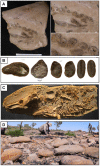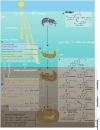Microbially mediated fossil concretions and their characterization by the latest methodologies: a review
- PMID: 37840715
- PMCID: PMC10576451
- DOI: 10.3389/fmicb.2023.1225411
Microbially mediated fossil concretions and their characterization by the latest methodologies: a review
Abstract
The study of well-preserved organic matter (OM) within mineral concretions has provided key insights into depositional and environmental conditions in deep time. Concretions of varied compositions, including carbonate, phosphate, and iron-based minerals, have been found to host exceptionally preserved fossils. Organic geochemical characterization of concretion-encapsulated OM promises valuable new information of fossil preservation, paleoenvironments, and even direct taxonomic information to further illuminate the evolutionary dynamics of our planet and its biota. Full exploitation of this largely untapped geochemical archive, however, requires a sophisticated understanding of the prevalence, formation controls and OM sequestration properties of mineral concretions. Past research has led to the proposal of different models of concretion formation and OM preservation. Nevertheless, the formation mechanisms and controls on OM preservation in concretions remain poorly understood. Here we provide a detailed review of the main types of concretions and formation pathways with a focus on the role of microbes and their metabolic activities. In addition, we provide a comprehensive account of organic geochemical, and complimentary inorganic geochemical, morphological, microbial and paleontological, analytical methods, including recent advancements, relevant to the characterization of concretions and sequestered OM. The application and outcome of several early organic geochemical studies of concretion-impregnated OM are included to demonstrate how this underexploited geo-biological record can provide new insights into the Earth's evolutionary record. This paper also attempts to shed light on the current status of this research and major challenges that lie ahead in the further application of geo-paleo-microbial and organic geochemical research of concretions and their host fossils. Recent efforts to bridge the knowledge and communication gaps in this multidisciplinary research area are also discussed, with particular emphasis on research with significance for interpreting the molecular record in extraordinarily preserved fossils.
Keywords: biomarkers; biominerals; biomolecules; concretion; fossil; microbes; organic geochemistry; paleontology.
Copyright © 2023 Dhami, Greenwood, Poropat, Tripp, Elson, Vijay, Brosnan, Holman, Campbell, Hopper, Smith, Jian and Grice.
Conflict of interest statement
The authors declare that the research was conducted in the absence of any commercial or financial relationships that could be construed as a potential conflict of interest.
Figures








References
-
- Aizenshtat Z., Krein E. B., Vairavamurthy M. A., Goldstein T. P. (1995). “Role of sulfur in the transformations of sedimentary organic matter: a mechanistic overview” in Geochemical transformations of sedimentary sulfur. eds. Vairavamurthy M. A., Schoonen M. A. A. (Washington, D.C.: American Chemical Society; ), 16–37.
-
- Al Disi Z. A., Zouari N., Dittrich M., Jaoua S., Al-Kuwari H. A. S., Bontognali T. R. R. (2019). Characterization of the extracellular polymeric substances (EPS) of Virgibacillus strains capable of mediating the formation of high mg-calcite and protodolomite. Mar. Chem. 216:103693. doi: 10.1016/j.marchem.2019.103693 - DOI
-
- Allison P. A. (1988a). The role of anoxia in the decay and mineralization of proteinaceous macro- fossils. Paleobiology 14, 139–154. doi: 10.1017/S009483730001188X - DOI
-
- Allison P. A. (1988b). Taphonomy of the Eocene London clay biota. Palaeontology 31, 1079–1100.
Publication types
LinkOut - more resources
Full Text Sources
Miscellaneous

